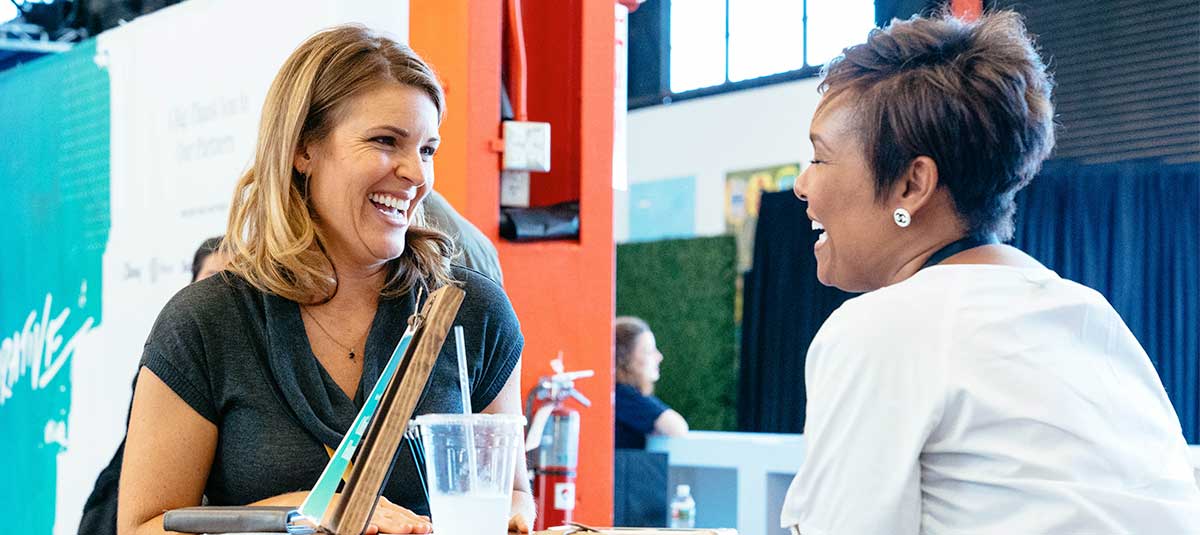Why Collaboration Takes Us Further Than Competition

The competitive spirit is a central element of human nature. Think about some of the ways we compete, both big and small, in our lives:
- Rushing to buy pre-sale tickets for a popular movie or concert
- Applying and interviewing for jobs
- Facing teams or individuals for sports championships
- Fighting with your siblings for the last slice of pizza
Competition is not inherently bad. In fact, it can be incredibly fun. However, competition can hold us back from achieving our greatest potential because it is inherently divisive. There can only be one winner.
Collaboration, on the other hand, is all about progressing as a whole. There is no winner unless the entire group crosses the finish line together.
In that light, collaboration is bigger than one person. It’s a culture. Any staff member, department, or organization that wants to prioritize collaboration over competition needs to weave it into the very fabric of who they are.
We met with Pat Walsh, cofounder and chief impact officer at Classy, to discuss the value in collaborating with our peers versus competing with them. Below, we discuss why this mindset is important, how we can scale it to the social sector at large, and different ways we can work together.
Collaboration Vs. Competition
First, it’s important to examine competition and collaboration in the context of individuals, teams, and work environments. Once we understand that, we can begin to think about different ways to go beyond one organization and impact the entire social sector.
David Mizne, author on the 15five blog, analyzes how people operate in collaborative or competitive settings. When it comes to competition, people are:
- Driven to achieve results through fear
- Prompted to perform beyond minimum requirements
- Encouraged to outperform their peers
As for collaborative environments, he writes that individuals:
- Stress less about losing their jobs
- Avoid the “fight or flight” instinct and thus improve creative brain functions
- Brainstorm and share ideas with peers more willingly
- Feel inspired to come to work, which can boost company-wide morale
Further, David writes that collaborative companies are “more profitable, productive, and efficient, with higher customer satisfaction and lower turnover. Their employees build cohesive, supportive cultures that appeal to customers, suppliers, and top talent alike.”
While a competitive work environment drives results, the way it drives them is by being fear-driven, overworked, and individualistic. Collaborative environments also drive results, but by way of positivity, teamwork, and creativity. And after detailed exploration, David arrives at the conclusion that collaboration is a clear-cut winner over competition.
The question for us is, how do you take this collaborative mindset and scale it beyond an individual, team, or organization to the entire social sector?
Remove the Ego
By nature, the social sector already supports a culture of collaboration. Pat tells us this is evident in the ways organizations share resources, fundraising advice, community building ideas, critical industry insights, and relevant data between each other.
Still, there’s an all-too-human element that gets in the way of true collaboration: the ego. As countless nonprofits work on behalf of worthy causes, they can also tend to focus on or prioritize their own organization’s role or mark on the cause over the progress that can be made in conjunction with others.
“There are no shareholders in the nonprofit sector the way there are in the corporate world. So, competition takes on a different context. If you’re really committed to solving a social problem it’s often necessary to take ego out of the equation.”
Competition, spurned by the ego, leaks into parts of the social sector when people want to be the first to achieve their mission. They want to be the first to bring fresh water to communities, end world hunger, or cure a disease.
If we can take the ego out of the equation though, we see that it’s not important who crosses the finish line first. Instead, it’s far more important that we cross the finish line at all.
According to Pat, we all have a responsibility to lift each other up so the social sector, as a whole, moves closer to accomplishing their goals. This commitment to each other flows between organizations in the same cause sector, but it also touches nonprofits across different cause sectors, for-profit companies, and corporate structures.
Foster Collaboration
There are countless ways we can lift each other up on a daily basis. It can be as simple as sharing lessons learned from your fundraising campaigns or pro tips for streamlining operational processes.
For example, you create a brilliantly effective peer-to-peer campaign that draws supporters in, makes it easy for them to fundraise, drives donations, and provides major boosts to your revenue. Publish a blog post that highlights your key takeaways for other nonprofits to apply to their next peer-to-peer campaign.
Maybe you found the magic balance of text and photos in your emails that increases click-through rates to a donation form. Share that insight with other nonprofits that rely heavily on email marketing to drum up support.
There’s even a chance for cross-pollination of insights between nonprofit and for-profit worlds. If you lock down a solid corporate partner, both you and your new partner can leverage the collaboration to help other nonprofits and for-profits find each other.
“Collaboration doesn’t necessarily mean you need to setup a partnership or engage in a larger-than-life deal to make a difference. It can be as simple as sharing ideas, lessons learned and best practices. Sometimes that’s the most effective way to help push the sector forward. That’s why we created the Collaborative.”
Give People a Platform
When you give people a platform to connect, great things can happen. At one of our past Collaborative events, Classy client Team Rubicon struck up a relationship with Palantir Technologies and entered into a partnership together.
Team Rubicon would use Palantir’s software to increase the efficiency of their disaster relief operations. But when Hurricane Sandy made landfall in 2012, Team Rubicon went into the field equipped with more than just Palantir’s software.
There was a team of Palantir engineers embedded alongside them, who built a way for Team Rubicon volunteers to collect requests for assistance, prioritize them according to urgency, dispatch resources, and track progress toward completion—all from their smartphones.
This is a golden example of what can happen when we prioritize collaboration, remove our ego from the equation, share our resources, and truly work together.
As you move forward and collaborate, think on this final quote from David Mizne:
“Collaboration is imperative for cultures who wish to step into true global impact.
The power to create lasting impact that elevates not just your organization, but the entire social sector, is at your fingertips. It doesn’t matter where you work, the size of your organization, or what your mission is: we’re all in this together.
To help foster collaboration and keep it top-of-mind, hold fast to these precepts:
- Always maintain an open mind and perspective
- Never stop challenging yourself to grow and develop in ways you might not understand yet
- Get out of your circle and comfort zone often
- Learn from as many different people as you can
Everything starts with you. If you want to take action today, we’d love to have you join us for this year’s Collaborative. We’re excited to see what you can do in a room filled with the social sector’s finest.

Join Us at the 2019 Collaborative



